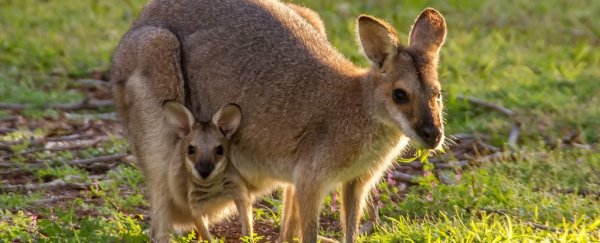For the swamp wallaby, mothering is a full-time business. While every other mammal on Earth gets a break between pregnancies, this particular species of Australian marsupial (Wallabia bicolor) is the only one to continuously have a bun in the oven. Sometimes, they even have two.
Before an expectant wallaby gives birth, her body is already preparing for another joey. Just a few days before the due date, these remarkable creatures will copulate again, a new study reveals. The new embryo is conceived in another, separate uterus, while still carrying a full-term foetus in the first.
"Conceiving during an active pregnancy is very tricky business," marsupial scientist Brandon Menzies told ScienceAlert, "which is why very few mammals to date have attempted this reproductive strategy."
After all, looking after one joey is tiring enough. And male semen could contain dangerous foreign material that might put that first pregnancy at risk.
Then, of course, there's the matter of sheer space. Kangaroos and wallabies have remarkable reproductive plumbing: three vaginas and two separate uteri, both complete with their own ovaries, oviducts, and cervices.
Similar to other macropods, like kangaroos, swamp wallaby joeys are born immature and incomplete, which means they need extra time in the pouch to feed and grow up a little.
But unlike a kangaroo, swamp wallaby ovulation time is shorter than their pregnancy length. As researchers have now discovered, this means these animals can conceive another life while still actively pregnant, alternating between two distinct uteri that operate in isolation from one another, including their hormonal control.
Granted, the overlap in pregnancies is only a few days. Once the newborn in the pouch begins suckling, this triggers signals that arrest the development of the other embryo, a concept known as diapause. This means the new life won't start growing again until the pouch is free, roughly nine months later.
Still, between a joey in the pouch and one in the womb, this means adult female wallabies are virtually always pregnant and lactating.
The ability to ovulate, mate, and conceive anew while still actively pregnant is a remarkable thing, and it's only been described once before in the European brown hare (Lepus europeaus).
Three or four days before giving birth, this little creature is known to copulate again, forming a new pregnancy. The difference is, the brown hare has distinct breeding seasons, which means it gets a break.
The swamp wallaby is not so lucky, although Menzies admits it's not all bad.
"While it sounds demanding on the female that she is permanently pregnant, for most of the time this tiny embryo is sitting in the uterus consuming almost no resources at all, and in fact I'm not sure the animal would even know it is pregnant."
Before this research, it was known that wallabies had a shorter ovulation period than gestation period, but Menzies and colleagues are the first to get a look under the hood.
Using high-resolution ultrasound and vaginal smears, the team tracked the pregnancy and mating of 10 female swamp wallabies, revealing that they ovulate and mate one or two days before giving birth, conceiving a new embryo during active pregnancy.
All other female macropods have an oestrous cycle slightly longer than their pregnancy length, which means they can mate and conceive again within hours of giving birth.
"It is not clear why the swamp wallaby ovulates and mates prepartum compared to all other macropodids," the authors write.
"It is unlikely to be related to any gain in developmental time of the embryo (one to three days) because this 'benefit' would be lost when the embryo enters its lengthy period of diapause."
Having developed in Australia's unique environment, marsupials continue to bring evolutionary surprises to the table.
"Studying marsupials is important because given their long period of evolutionary isolation from [placental] mammals, they often find novel solutions or work-arounds to common problems," Menzies told ScienceAlert.
"Our current research is another example of when a marsupial has defied the norms of what we think is possible in reproduction, by using what it has and doing things a little differently."
The study was published in PNAS.
